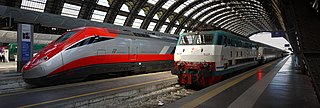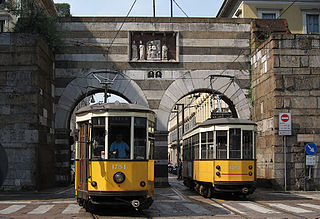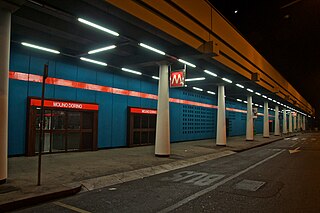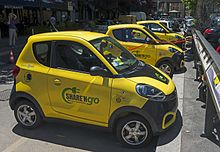
The Italian railway system is one of the most important parts of the infrastructure of Italy, with a total length of 24,227 km (15,054 mi) of which active lines are 16,723 km (10,391 mi). The network has recently grown with the construction of the new high-speed rail network. Italy is a member of the International Union of Railways (UIC). The UIC Country Code for Italy is 83.

The Milan Metro is the rapid transit system serving Milan, Italy, operated by Azienda Trasporti Milanesi. The network consists of 5 lines with a total network length of 104.1 kilometres (64.7 mi), and a total of 113 stations, mostly underground. It has a daily ridership of about 1.4 million on weekdays. The Milan Metro is the largest system in Italy for length, number of stations and ridership; and the seventh longest in the European Union.

The Socimi Eurotram (later sold as the Bombardier Flexity Outlook (E)) was an electric tramcar designed for the tram system of Compagnie de Transports Strasbourgeois (CTS). Initially produced by Socimi, after the company became bankrupt Eurotrams were manufactured first by ABB Group's transportation division, then by Adtranz and finally by Bombardier Transportation, who marketed the tram as part of their Flexity Outlook range.

Line 1 is the first underground rapid transit line built in Milan, Italy. It is part of the Milan Metro and it is operated by ATM. Works on the line began in 1957, and the first part was opened on 1 November 1964, running from Sesto Marelli to Lotto station. The line is also called Red Line, as it is visually identified by red signs. Due to its premiership, the line gave its red color to the Milan Metro logo.

The Malpensa Express is an airport rail service linking the city of Milan with Malpensa Airport, in the region of Lombardy, Northern Italy.
Azienda Trasporti Milanesi S.p.A. is the municipal public transport company of Milan and 46 surrounding metropolitan municipalities. It operates 5 metro lines, 17 tram lines, 120 bus lines and 4 trolleybus lines, carrying about 776 million passengers in 2018.

Line 5 is an underground rapid transit line in Milan, Italy, part of the Milan Metro. The line, also known as M5 or the Lilac Line, is 12.8-kilometre (8.0 mi) long and goes through the city from the north to the north-west. It opened in stages between 2013 and 2015.

The Italian city of Milan is one of the international tourism destinations, appearing among the forty most visited cities in the world, ranking second in Italy after Rome, fifth in Europe and sixteenth in the world. One source has 56% of international visitors to Milan are from Europe, 44% of the city's tourists are Italian, and 56% are from abroad. The most important European Union markets are the United Kingdom (16%), Germany (9%) and France (6%). Most of the visitors who come from the United States to the city go on business matters, while Chinese and Japanese tourists mainly take up the leisure segment.

Cadorna FN is an underground interchange station in Milan, Italy, serving Lines 1 and 2 of the Milan Metro. The Line 1 station was opened on 1 November 1964 as part of the inaugural section of the Metro, between Sesto Marelli and Lotto. The Line 2 station was opened on 3 March 1978 as the southern terminus of the extension from Garibaldi FS. It served as the southern terminus of Line 2 until the extension of the line to Porta Genova on 30 October 1983.

Lanza is an underground station on Line 2 of the Milan Metro. The station was opened on 3 March 1978 as part of the extension from Garibaldi FS to Cadorna.

Moscova is an underground station on Line 2 of the Milan Metro. The station was opened on 3 March 1978 as part of the extension from Garibaldi FS to Cadorna. The distance from the Lanza station is 550 meters.

Garibaldi FS is a station on Lines 2 and 5 of the Milan Metro, and the Milan Passante railway. The Line 2 station was opened on 21 July 1971 as part of the extension from Centrale. It served as the western terminus until 3 March 1978, when the first trains could travel the new route to Cadorna. The Passante station was opened in 1997, and the Line 5 station in 2005.

Centrale FS is a station on Lines 2 and 3 of the Milan Metro in Milan, Italy. The Line 2 station was opened on 27 April 1970 as a one-station extension from Caiazzo. On 21 July 1971, the line was extended to Garibaldi FS. The Line 3 station was opened on 1 May 1990 as part of the inaugural section of the line between Duomo and Centrale. Initially, Duomo was connected with Centrale by shuttle service, and on 16 December 1990, with the extension of the line to Porta Romana, full-scale service started. The station remained the terminus of Line 3 until 12 May 1991, when Sondrio was opened.

The Milan tramway network is part of the public transport network of Milan, Italy, operated by Azienda Trasporti Milanesi (ATM).
Azienda Napoletana Mobilità SpA, more commonly known simply as ANM, is a municipally controlled public company that is the primary provider of urban public transportation in the city of Naples, Italy, and also provides a portion of the surface transit service in surrounding municipalities. In addition to a network of tram, trolleybus and motorbus routes, ANM operates the Naples Metro system and four urban funiculars. The metro system and funiculars were operated by a different company from 2001 to 2013, when they again became part of ANM.

Lampugnano is an underground station on Line 1 of the Milan Metro in Milan, Italy. The station was opened on 12 April 1980 as part of the extension from Lotto to San Leonardo. It is located on Via Giulio Natta, in the Lampugnano district, from which it takes its name. It is located near the Palasharp and the main terminal for intercity bus service.

Molino Dorino is a station on Line 1 of the Milan Metro in Milan, Italy. The station was opened on 28 September 1986 as a one-station extension of the line from San Leonardo. On 14 September 2005, the line was extended to Rho Fiera; Pero station was only added on 19 December 2005. It is an underground station, located near the city limit. The station is located between Via Molino Dorino and Via Francesco Cilea.

Isola is a station on Line 5 of the Milan Metro. It takes its name from the Isola (island) district of Milan in which it is located, its name derived from the neighbourhood's position cut off from the city centre by the main railway.

The Metropolitan City of Milan is a metropolitan city in the Lombardy region of Italy. It is the second most populous metropolitan city in the nation after the Metropolitan City of Rome Capital. Its capital is the city of Milan. It replaced the province of Milan and includes the city of Milan and other 132 comuni. It was first created by the reform of local authorities and then established by the Law 56/2014. It has been operative since 1 January 2015.

Domodossola FN is a station on Line 5 of the Milan Metro which opened on 29 April 2015.




























